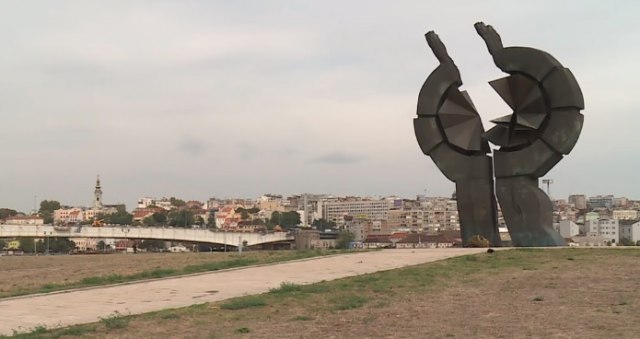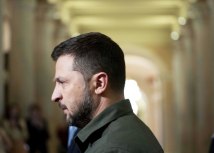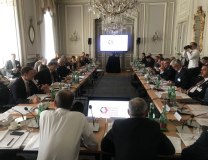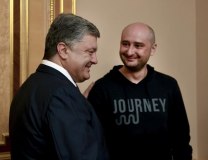When will Serbia get Staro Sajmiste Memorial Center?
“He who controls the past controls the future;
He who controls the present controls the past.”
George Orwell

This quote is taken from Zygmunt Bauman's afterward to his work "Modernity and the Holocaust." The title of the afterward reads: "The Duty to Remember - But What?"
Although I/we think that we are a part of the common places, the correct roles that our ancestors had, various forms of behavior of the society, the elites, the leaders, have been to say the least confusing, and we are closer to assessing that there has been a conscious intent to revise.
For more than a decade, I thought I was participating in a nationally and globally unambiguously important and factually confirmed project: the story of the crimes committed at Staro Sajmiste (Old Fairgrounds) in downtown Belgrade.
Although it never occurred to me as a possibility, it's as if this dilemma prevailed in the period of our near past, while we still need to question the exact documented memories and facts related to the events at Staro Sajmiste, from 1941 to 1945. The vast majority of the citizens of Belgrade and Serbia have no idea that there was a German JudenLager Semlin in that place, where over 6,000 women, children and the elderly, the sick, Belgrade and Serbian Jews, were killed from December 1941 until May 1942. Before November, more than 5,000 Jewish men and some 1,500 Roma were put to death at the Topovske Supe site. (In May, a certain Gestapo chief sent a telegram to Berlin announcing that Belgrade had become the first Judenfrei (free of Jews) city...). At the same time, when it comes to the liberation movement, according to the number of the righteous people, we can be proud of the behavior of the citizens of Serbia, as we should be embarrassed by those who belonged to the collaborationist movement. Afterwards, a large number of people (from 10,000 to 25,000) - mostly Serbs, for example, patriots, those from Kozara (in Bosnia), etc, but also members of other nations from the region, died in the Transitional Camp.
When looking at the content of the media in the past twenty years, one would say said that the publicity is on the side of the quislings, through an attempt to revise history, while in the case of the victims, we only have big words, but not the building of memorials and educational programs that would bring to the forefront the best side of our history, the liberation, anti-fascist movement and solidarity with the Jews, the Roma, etc... If somebody looks from the side, they might conclude that there is doubt about whether the values of anti-fascism had been the correct majority decision.
My encounter with the Holocaust in Belgrade began when we came across the dilapidated Ogen Sabat building that we managed to get from the Stari Grad Municipality to host an alternative cultural center, which we later named Cinema Rex. We soon turned the ruined building into a beautiful place of culture with a large exhibition entitled "The Neighbors Who Are No More", about the Jews who lived in Dorcol until 1941. The reconstructed facade made it an unavoidable place of pilgrimage. Everything that we did was in harmony with the approval of the Jewish Community (the premises were sold by the Jewish Municipality of Belgrade to the Municipality of Stari Grad, it was not taken away as was usually the case). From that place, I learned a lot about the fate of the Belgrade and Serbian Jews, among others, in Staro Sajmiste and Topovske Supe, in Pancevo, Bezanijska Kosa, Jajinci, etc...
For years I've been passing by this big killing ground that seems not worthy of being marked as such, Staro Sajmiste. Facing the knowledge that it is not widely known what happened in that place, we at B92 created a reconstruction, in the form of a two-part documentary film, made in 2007. That's how our more intensive engagement started. We quickly became part of the International Coalition of Sites of Conscience... We became the most important landmark in terms of the need to create a memorial at this place.
Our celebrated designer Mirko Ilic invited the world's greatest designer Milton Glaser to together create the Memorial's symbol.
A number of creative people from all over the world wanted to come to this site when they visited Belgrade, all of them offered their services, from interior designers that worked on similar memorials, to world-famous Libeskind, who pledged to design this space pro bono.
Visiting this area frequently, and offended by announcements of entertainment events in the Spasic Pavilion, I often sent information to Efraim Zuroff, the director of the Simon Wiesenthal Center, who would then react publicly in an effort to lessen the desecration of this area. When I noticed that the space that was once part of the Turkish Pavilion had been abandoned - where the mortuary was located during the era of the camp - I asked the Municipality of New Belgrade to repair that space and create an office for the future memorial, with the idea that this will launch the construction of the Memorial even before big decisions about the entire space have been made. The president of the Municipality of New Belgrade at the time was a great supporter of the idea to create a memorial in that area. However, in the same week, I learned that the director of the New Belgrade Business Premises had leased out this space to a restaurateur. And thus we got the So i Biber restaurant, which remains in the same place today, in an area of the mortuary of a Holocaust site, and across the road from the Spasic Pavilion - a former hospital where people were receiving treatment less and dying more - where weddings and other happy occasions were celebrated... Today, there is another restaurant in that spot.
When I informed then Belgrade Mayor Dragan Djilas about this, he was shocked, and shouted a lot during a telephone conversation - probably with the director who leased out that space - but nothing important happened.
When the first Commission for Staro Sajmiste was established, we were meeting in the City Hall Assembly, whose walls are adorned by photographs of all Belgrade mayors, including the war criminal Dragomir Drago Jovanovic, who was the quisling manager of the city of Belgrade and the head of the Belgrade police during the occupation. It was only after members of the Commission threatened to resign unless the image of this criminal has been removed, that it was removed - and then put back up. It may have been a very plastic cautionary tale about what will in fact be more challenging than building the Memorial itself. (That was also the time of Acting Mayor Zoran Alimpic). Often, I heard that this is an extremely valuable piece of land, from which the city would make much more income if it was used for commercial purposes, such a shopping mall or some entertainment institution.
After the changes, when the SNS-SPS coalition came to power, there was a change in the composition of the Commission, and Aleksandar Vulin, then Minister of Labor, Social Policy and Veterans Affairs, showed a strong interest in participating. The Commission was strengthened by having Jovan Culibrk as its chairman - who is certainly among those with the best knowledge of the Holocaust, who studied it at Yad Vashem. However, the Commission was at the city level, and the law was written under the umbrella of the Ministry of Labor... And soon we were all surprised by one of the first drafts that spoke about the institution of the memorial to the victim, and not about the Staro Sajmiste Memorial Center - while the preamble spoke about the memory of the (WW1) Albanian Golgotha, the Serbian freedom-loving traditions and the Vidovdan ethics of the victim, and about the feat that gives meaning to the historical activity of the Serb people, and points to the awareness of the sacred obligation to the glorious ancestors, as a nation small in number, but of great historical character, etc...
A portion of the Commission, to which I belonged, objected to giving this name/title to the complex, and to such a preamble, and advocated in favor of a name that is related to this toponym which is recognizable, with a possible compromise such as, "The Institution of the Memorial to the Victim Staro Sajmiste" or similar, as well as specifying articles in the law that would more clearly link to the events that took place in this place, and the wider Yugoslav and European context in which this killing ground was functioning.
When a problem arose with the fact the second place of suffering that preceded the Holocaust site at Staro Sajmiste, Topovske Supe, was about to get permission to build a place of entertainment, the largest shopping mall in Europe, as announced by Delta, the investor - the Commission's representatives objected by consensus to the existing memorial area - two buildings of the former barracks and a reception camp - being demolished and displaced. (At that time a representative of the Institute for the Protection of Cultural Monuments of Belgrade revealed that representatives of the Jewish Municipality of Belgrade and the Roma community had already given permission to Delta for the appearance of the shopping mall, which exists as a conceptual solution: pictures of the conceptual solution attached...) Only after learning this, it was asked during a meeting of the Commission that the Alliance of Jewish Municipalities of Serbia, as well as the Roma community, withdraw their consent because it was emphasized that this space should not be subordinate to a place of entertainment - but exactly the opposite, that the conceptual solutions should respect the memory of the space, and to adapt to it.
After these events, events related to the new law also accelerated. The Commission received a new version of the law, in which a portion of the controversial preamble became an article of the law, which was even more absurd... The law itself had been changed in the sense that it was no longer a special law to be passed by the government and an institution to be established by the government because of its specific nature and complexity, both when it comes to its content and management - instead it was envisaged that the founder will be the Ministry of Culture, while the provisions of the law were very broad, so that all the specific features of the institution, which were envisaged inside the institution, would more paralyze its work than enable it. After all, the Ministry of Culture and Information itself gave a negative opinion on the draft law. It was planned to bring in the Genocide Museum with all of its controversial heritage. The broadest autonomy - independence of the Holocaust Museum was not envisaged (because that requires what happened in this space, and that is the name of JudenLager Semlin and the almost complete destruction of the Jewish community in Belgrade-Serbia), nor assistance to the Museum of Porajmos, because the Roma community needs big support, unlike the Jewish community that has both the artifacts and resources, a relationship with the Museum of Genocide, etc...
At the last session of the Commission for Staro Sajmiste, on Friday, June 29 - where a completely new draft of the law was presented - the idea was presented that the law should be adopted by urgent procedure, with a paradoxical explanation that the 75th anniversary of the prisoner breakthrough at the camp will take place in two years from now. The Ministry and the government have been unacceptably delaying the work on the draft law, and then everything changed, from what were the topics of discussion at the Commission. At the same session, we could also hear statements that a public hearing was conducted while the law was being written. This is an absolute falsehood, which I emphasized at the session of the Commission, concluding that this is such an important issue that it is absolutely impermissible for the debate on the Law to leave out organizations dealing with memorization, youth organizations, the non-governmental sector, professional organizations... It is inconceivable that those who did not have their say on text of the law and the future of the Memorial include the International Advisory Board established by the Commission, composed of highly credible global experts, led by Efraim Zuroff, director of the Simon Wiesenthal Center (other members of the International Advisory Board: Dr. Robert Rozett, Director of the Libraries Yad Vashem, Michael Berenbaum, American professor, writer and rabbi, Holocaust expert Laszlo Csosz, senior historian at the Holocaust Memorial Center in Budapest Thomas Lutz, director of the Berlin Memorial Museum, Karen Shawn, associate professor of Jewish Studies at Yeshiva University, Bruno Boyer, Shoah Holocaust Memorial in Paris and President of the International Holocaust Remembrance Alliance (IHRA), and Dr. Goran Hutinec, docent at the University of Zagreb. There were never any funds to bring them to Belgrade.)
This body has never met for a constituent meeting, nor has it ever been consulted on any issue. The law itself is not sufficient. It is impermissible for the temporary organs of the memorial to deal with writing its statute. I think that, in parallel with the drafting of laws, it is necessary to foresee all possible relations within the Memorial, in order to enable its efficient functioning, permanently protect its autonomy, while the umbrella institution appointed by the government of Serbia would be precisely the International Board, represented by the aforementioned authorities, along with Milan Koljanin and some other important major domestic authorities, without whose confirmation it is not possible to make any important decisions in order to prevent any politicization and possible historical revisionism due to a change of government, and the like.
For many years the evacuation of the central tower (at Staro Sajmiste) had been taking place, that housed ateliers of artists. Once it was over, the city government did not secure the space, into which a Roma family moved. To this day it remains one of the main problems (more of an alibi) preventing the continuation of the works. The city does not want to tackle the problem of this family, while forceful eviction would damage the mission and the function of this area. Similarly, the Italian Pavilion, the Czech Pavilion both have their tenants, a small number of them, but the city government did not go into this task fully resolved and with a plan, so it is still unknown when the evictions would take place, and when the premises would be freed up for reconstruction, primarily for protection, but also for museological, memorial, educational, scientific and research, prayer purposes. The question of the Spasic Pavilion is a special, but also a very important topic. This building from the endowment of the Nikola Spasic Foundation was privatized in the 1990s and is today the private property of a gym, an entertainment hall, a tourist organization, a restaurant, a cafe, etc... When the Jewish community asked for the German Pavilion as the Holocaust Museum site, the city authorities claimed it was impossible because precisely at this spot the Vladimira Popovica Street extends - to connect the shopping center Usce with other transport routes. At that time, the most commonly mentioned promise was that the Spasic Pavilion would be bought back, or in a similar way allocated to the Museum of the Holocaust.
This is hardly feasible, there are no guarantees, there is no bill of law nor any planned budget allocations, which would show the intention of the state to buy back the sole healthy, maintained building in this area from the current owner, or exchange it - which is certainly possible, when it comes to the spaces owned by the city.
As things stand now, when it comes to this important Memorial, we will wait a long time unless the same mechanism is applied that has been applied across the river, for the Belgrade Waterfront area. Tens of hectares have been cleared up within a year and all facilities in that area have been, through a special law, documentation-wise arranged and handed over to the investor. And when it comes to the case of Staro Sajmiste, which is a much simpler venture, there is no solution that would result in the construction of the Staro Sajmiste Memorial, under the supervision of world authorities, in a short period of time, in order to avoid any stain that could be inflicted by rehabilitation of quislings, war criminals, collaborators of the occupiers, etc... Playing with the victims and demeaning them should not be permitted, as has been done with Jasenovac and numerous other killing grounds. On the contrary, such places - from Banjica, Jajinci, Kragujevac, etc., must reflect the respect toward victims and be an unambiguously anti-fascist signpost, of patriotism and belonging to a positive world coalition in both world wars. Without any additional complicating by connecting to the myths and notions that do not have factual basis. Until we mark this place in a worthy fashion too, without any games, it is very questionable whether we have the right to criticize others even when authentic arguments are being used. At the same time, this space must remain untouched by political and other interests, which would compensate for other interests in other areas. No one should compromise facts that are frightening in themselves and which say that we must do everything for it to never happen again, while the first step is to tell the full truth about what happened here without any exaggeration and functionalization. The facts themselves are frightening enough.
Holocaust museums from Washington to Berlin, the Simon Wiesenthal Center in Los Angeles, the Shoah Memorial in Paris, Yad Vashem, are central memorial, museological and educational institutions, most often among the most visited in the cities in which they are located. The position of Staro Sajmiste and a well-thought-out, modern memorial of the Holocaust, genocide, a museum of camps and fairgrounds, of Porajmos, can become a great Belgrade and Serbia story of facing the evil past, a space of sadness and respect, memories, education and prayer. Precisely as a counterpoint to the space of hedonism and entertainment that is being built on the other side (of the river). Perhaps it would not be adequate to mention the Arab capital, on one side, and a Holocaust museum on the other, but I do not see any reason why planning, administrative permits, development and construction go smoothly on one side, while on the other we have difficulties that are inexplicable, when it comes to establishing an institution that should be of highest national importance, since its international significance has long been recognized.










